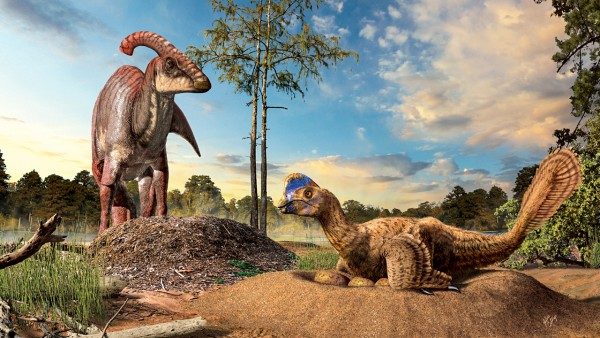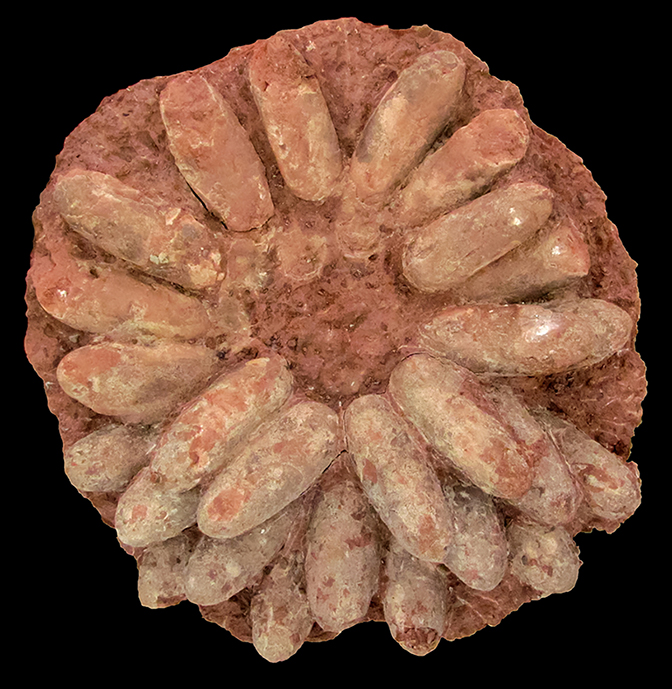- Tel: +86 813 2105845
- Fax: +86 813 2105845
- Mob: +86 13778532392
- Contact: Mr. Jacky
 info@dinosaurs-world.com
info@dinosaurs-world.com Jackydinosworld@gmail.com
Jackydinosworld@gmail.com Jackyyiming@gmail.com
Jackyyiming@gmail.com Jackyzengdinosaursworld
Jackyzengdinosaursworld
- Missing link between dinosaur nests and bird nests

Analyses of fossil eggshells suggest that duck-billed dinosaurs (depicted at left) buried their eggs in mounds of vegetation like today’s crocodiles, whereas evolutionarily advanced, more birdlike dinosaurs such as oviraptorids (right) incubated their eggs in an open nest.
The links between dinosaurs and birds keep getting stronger: skeletal structures, feathers—and now nests. Whereas some dinosaurs buried their eggs crocodile-style, a new analysis suggests that other dinosaurs built open nests on the ground, foreshadowing the nests of birds.
Interpreting the fossil record is always tough, but analyzing trace fossils such as nests is especially daunting. Those structures, and the materials used to make them, usually aren’t preserved, says Darla Zelenitsky, a paleobiologist at the University of Calgary in Canada. When paleontologists do find a nestlike structure that includes material such as sticks or other vegetation, the question arises: Was this stuff part of the original nest, or just carried there with the sediment that buried the nest and helped preserve it?
To gain insight into dinosaur nesting habits, Zelenitsky and her colleagues studied the most durable parts of nests—the eggs themselves. (Being largely made of the mineral calcium carbonate, they’ve got a head start on fossilization and are sometimes incredibly well preserved.) In particular, the team looked at the size and arrangement of small pores in the ancient shells, because those details are telling in modern creatures.
A nest of fossilized eggs from an oviraptorid dinosaur of the Late Cretaceous period.
In crocodiles’ buried nests, the heat needed to incubate the eggs comes from decomposition of overlying organic matter or the sunlight absorbed by the soil. Plus, in buried nests airflow is somewhat limited, thus requiring eggs to be relatively porous to help increase the flow of oxygen into and carbon dioxide out of the eggs. But birds that brood in open nests can get by laying eggs with fewer or smaller pores.
So the team compared the porosity of eggshells from 29 species of dinosaurs (including large, long-necked herbivores called sauropods; bipedal meat-eaters called theropods; and duck-billed dinosaurs) with that of shells from 127 living species of birds and crocodiles.
Most of the dinosaur eggs were highly porous, suggesting that they buried their eggs to incubate them, the researchers report online today in PLOS ONE. But some of the dinosaur species in one group—a subset of well-evolved theropods considered to be the closest relatives of modern-day birds—laid low-porosity eggs, which suggests they incubated their eggs in open nests.
“This is a well done paper; the results make a lot of sense,” says Luis Chiappe, a vertebrate paleontologist at the Natural History Museum of Los Angeles County in California. The findings, he says, line up other studies suggesting that some birdlike dinosaurs were warm-blooded, which would have enabled them to incubate eggs in an open nest rather than depend on rotting vegetation or sunlight. Chiappe adds that the trend toward open nests could have allowed some dinosaurs to take another step toward birdlike nesting by moving their nests into the trees.
But considering only two types of nests—open versus buried—may be too simplistic, suggests Anthony Martin, a paleontologist at Emory University in Atlanta. Some dinosaurs—like a few of today’s birds—may have nested in burrows, which could have offered the stable temperature and protection from predators of a buried nest but resulted in low-porosity shells. Also, covered nests come in different types: Loose vegetation piled atop a buried nest can have a lot of airflow through it, allowing eggs to have relatively small pores, whereas eggs buried in soil or similar materials might not breathe as well and thus require larger pores, he notes. Nevertheless, Martin adds, the team’s study “is a good first start toward answering the question about what early dinosaur nests looked like.”

 2015-11-26
2015-11-26
 New dinosaur species help scientists fill in evolutionary gaps
New dinosaur species help scientists fill in evolutionary gaps Feathered everything: just how many dinosaurs had feathers?
Feathered everything: just how many dinosaurs had feathers? Dinosaur Fossil With Fleshy Rooster's Comb Is First of Its Kind
Dinosaur Fossil With Fleshy Rooster's Comb Is First of Its Kind Scientists finally decode how dinosaurs turned into birds and learned how to fly
Scientists finally decode how dinosaurs turned into birds and learned how to fly Dark matter may have killed the dinosaurs, claims scientist
Dark matter may have killed the dinosaurs, claims scientist New duck-billed dinosaur uncovered in Alaska, researchers say
New duck-billed dinosaur uncovered in Alaska, researchers say
- Contact Us
- Tel: +86 813 2105845
- Fax: +86 813 2105845
- Contact: Mr. Jacky
 info@dinosaurs-world.com
info@dinosaurs-world.com Jackydinosworld@gmail.com
Jackydinosworld@gmail.com Jackyyiming@gmail.com
Jackyyiming@gmail.com Jackyzengdinosaursworld
Jackyzengdinosaursworld
- Copyright @ 2009 - 2020 Zigong Dinosaurs World Science & Technology Co.,Ltd.

